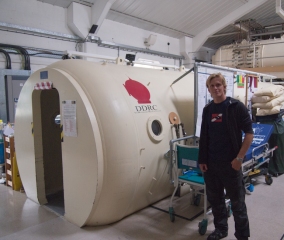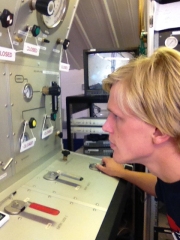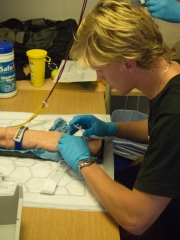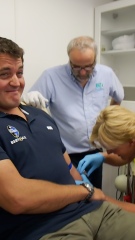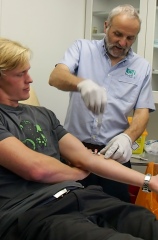what happens? When you stand on a paradise island far away from civilization, your buddy comes up from a dive and start to show signs of DCI, what will you do? When opening a 3l tank of oxygen and waiting for the ambulance is not enough and you might have to wait hours or even days before you can get to a doctor.
These are the sorts of questions that the Diver Medic Technician course addresses and I went to the Diving Diseases Research Center (www) in Plymouth to learn more. The course is usually attended by many commercial divers, working in saturation out in the north sea or similar remote locations. There is no evacuation to a hospital when you have two weeks of decompression to do. The DDRC has been working with and for divers for over 30 years and as the name suggests they do research on diving issues as well as education and treatments. The center is located next to a hospital and they don´t only treat divers coming in with decompression problems but all sorts of patients where hyperbaric oxygen can help them to heal, e g wounds with trouble in the oxygen perfusion etc.
On site DDRC have a knowledgeable staff with various backgrounds, many of them with a long history of diving. Our course was run by Paul, a man with many stories to tell that made the serious topics become fun. Like all first aid courses we started with the basics of life support , what to do when all the tools you have are your hands and you need to keep someone going until you can get more help. But as time went on we started to introduce a larger range of medical aids that can easily be carried in a bag and significantly increase your possible actions in an emergency. Before long we had three bags full of stuff to use and an idea of what to do with all the things in them. Through various scenarios we had the chance to practice advanced airway management, AEDs, wound care and multiple casualties. I also had the opportunity to give chamber handling a try even thou this is normally not covered in the course but they have a number of recompression chambers on site including two that are rated to 200 meters.
The DMTs responsibilities can range from assisting a doctor to being the one on site that is in charge of accident management. You should have an idea of how to a lot of different procedures and possibly act as the eyes, ears and hands of a doctor on the other end of a phone. The course covers how to assess a casualty’s condition and report it on. It also covers things like stitching someone up, relieving a pneumothorax and putting in an intravenous cannula (the last one was best practiced on other students).
One of my favorite parts of the course was when Ron, one of the training directors, took us to the emergency department one evening to act as observers. To see the nurses and doctors methodically work on patients that sometimes were quite poorly and all the time using the same basic principles that we had learned was a really good experience. I can say that I was impressed by the calm they showed and how they even had time to joke with their patients and spare some time to explain to us what they were doing.
Over a two week course I learned a lot of new things and definitely gained a lot of confidence in my own ability to do something useful in an emergency, be it in diving or elsewhere. I would be able to grab that big bag of stuff, rip it open and actually make good use of the aids inside. If we want to explore some of the more remote areas left on our planet we have to always be prepared to care for the people involved if something would happen even if we hope that we´ll never have to.
